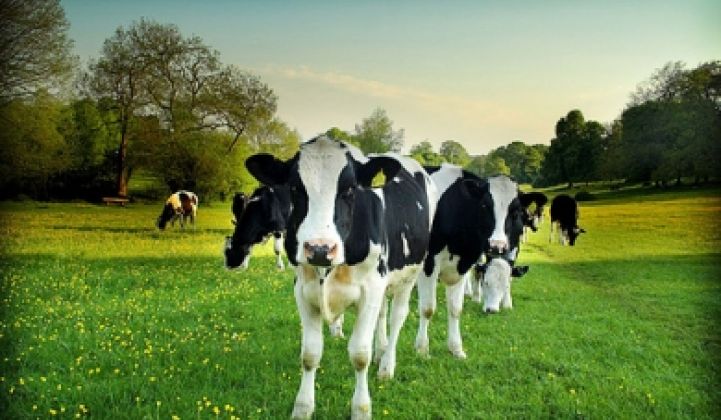Tossing plastic cups into recycling bins seems like an eco-friendly behavior. But for Gary Hirshberg, sending trash to another location where more energy will be spent re-making the existing plastic product into another plastic product represents a failure to be sustainable.
"The success is when you finish the yogurt and then you eat the cup," said Hirshberg, CEO of Londonderry, N.H.-based Stoneyfield Farm, at Greentech Media's Greening the Supply Chain conference in Boston Thursday.
Hirshberg used his keynote to extol the virtues of finding healthier raw materials and chopping energy use and carbon footprints before products roll out of factories. He noted that making a 16-ounce cup of coffee, for example, requires 208 liters of water plus the water that goes into growing coffee beans and cows (for milk), as well as other steps along the way before you even get to sip that cup of joe.
From manufacturers to retailers, businesses are paying more attention to where and how they obtain and produce raw materials and finished goods, and how they transport and sell them.
The growing public interest and public policies to cut man-made greenhouse gas emission have forced companies to examine their carbon footprint. It was certainly a moment of reckoning when Walmart announced earlier this year that its suppliers would have to track their emissions and report practices such as water use and waste treatment. The retail giant plans to use the data to create labels to tell consumers how sustainable are its merchandise.
The U.S. Environmental Protection Agency has finalized a proposed rule to collect emissions data from various industries, a policy that is set to go into effect in 2010. The EPA first issued its proposed rule in March this year.
Hirshberg said he and others at Stoneyfield, a producer of organic yogurt, began thinking about making healthier products and cutting energy use long before the ideas became vogue.
Still, convincing farmers to change how they raise milk cows probably wasn't easy. Stoneyfield analyzed the emissions of its products and realized that 49 percent of them came from the agricultural practices of its suppliers. Packaging accounts for 13 percent, manufacturing 9 percent, distribution 21 percent and end-of-life (from supermarkets to consumers) 8 percent.
"We can't ask consumers to lie under the cows and eat yogurt that way. But there are some other ways, when you start to think about bulk production and larger volumes that are more efficient," Hirshberg said.
What Stoneyfield came up with last year was its "Greener Cow Project," in which 15 farmers in Vermont that supply milk to the company began to feed their cows alfalfa, flax and grasses instead of corn. Corn has been a common feed that requires lots of energy to grow. Plus, it's not healthy to have cows eat nothing but corn – the corn affect a cow's digestive process, Hirshberg noted.
After six months of running the project, Hirshberg said the company experienced, on average, a 12 percent reduction on methane emissions. About 2 percent of the U.S.'s total greenhouse gas emissions came from the dairy industry, mostly from cows belching out the gas as part of their digestive process. ("The milk is probably not very good," he said.)
What Stoneyfield also found was an increase of healthy omega-3 in the milk by almost a third. The cows also are likely to have longer milk-producing years as a result of having a better diet, Hirshberg said.
"We are improving the quality of the supply chain, which is job security for me and my colleagues," he said. "It will make my farmers more profitable."
Stoneyfield Farm has also closely examined the emissions from transporting raw materials to its factories, and found that sourcing them locally doesn't always lead to a lower carbon footprint.
When there appeared to be a shortage of organic milk within the United States two years ago, Stoneyfield looked for sources outside of the country and found that the emissions from getting organic milk powder from New Zealand would be 60 percent lower than getting organic milk from the American Midwest, Hirshberg said. That's because New Zealand farmers feed their cows grasses instead of the more energy-intensive corn, he said (the company ended up not importing milk powder from New Zealand).
Another example: Emissions produced by sending a full truck of yogurt to New York is lower than those generated from sending two pallets of yogurt to Vermont.
"It's a misguided notion that it's always going to be a lower footprint if it's local," he said.
Image via Skinnyde / Creative Commons



